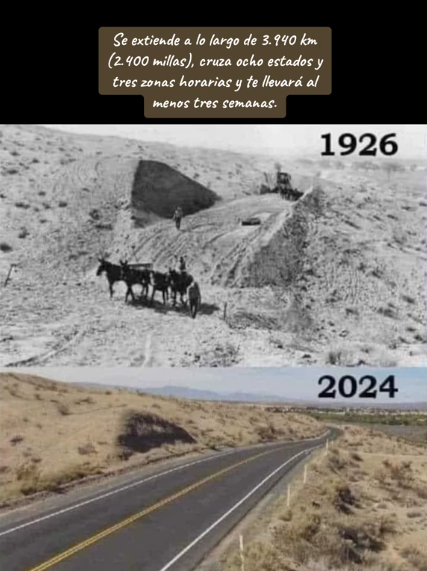U.S. Route 66, often called the “Main Street of America” or “Mother Road,” is an iconic highway that embodies the spirit of freedom and adventure. Spanning 2,400 miles (3,940 km) across eight states and three time zones, this historic route takes travelers on a journey through time, culture, and geography, from the bustling streets of Chicago to the sunny shores of Santa Monica in Los Angeles. Although the original road no longer exists in its entirety, Route 66 remains a quintessential American road trip, offering a mix of nostalgia, history, and small-town charm. Let’s explore this route with archeology.dulichvn.net
The Birth of the Mother Road to U.S. Route 66
A Vision for Connectivity
Route 66 was officially commissioned on November 11, 1926, as part of the original United States Numbered Highway System. Its creation aimed to connect rural areas with urban hubs, facilitating commerce and travel across eight states: Illinois, Missouri, Kansas, Oklahoma, Texas, New Mexico, Arizona, and California. Spanning approximately 2,400 miles (3,940 km), Route 66 linked Chicago to Santa Monica, crossing diverse terrains and cultural landscapes.

The road was revolutionary in its design, favoring a diagonal route that cut through the heartland of America, unlike the grid-like layout of many highways at the time. This approach provided a more direct and practical connection for freight transportation, earning Route 66 the nickname “The Main Street of America.”
A Lifeline During Hard Times
During the Great Depression of the 1930s, Route 66 became a vital lifeline for families displaced by economic hardship and environmental disasters, such as the Dust Bowl. Thousands of people, particularly from the Midwest, used the highway to migrate westward in search of work and a better future.
The highway gained literary fame through John Steinbeck’s The Grapes of Wrath, which chronicled the struggles of migrant families heading west along Route 66. Steinbeck immortalized it as the “Mother Road,” a name that resonated with its role as a path to new beginnings.
See more: The Tomb of Amyntas: A Marvel of Lycian Architecture in Fethiye, Turkey
World War II and Economic Growth
In the 1940s, Route 66 played a crucial role in the war effort. It facilitated the transportation of troops and supplies across the country and connected military bases in remote areas. The increased use of the highway during this period also spurred economic growth, with numerous businesses, including motels, diners, and gas stations, flourishing along the route.
Post-war America saw a surge in car culture and leisure travel, with families embarking on road trips along Route 66. This era cemented the highway’s reputation as a symbol of freedom and exploration.
The Decline and Preservation of Route 66
The Interstate Highway System
The 1950s marked the beginning of Route 66’s decline with the introduction of the Interstate Highway System under President Dwight D. Eisenhower. Inspired by Germany’s autobahns, this new system prioritized high-speed, limited-access highways designed to accommodate growing traffic volumes.

Interstates like I-40, I-44, and I-55 gradually bypassed Route 66, rendering many of its segments obsolete. Businesses along the highway suffered as travelers opted for faster, more direct routes. By 1985, Route 66 was officially decommissioned, marking the end of its era as a primary highway.
Efforts to Preserve a Legacy
Despite its decommissioning, Route 66’s cultural and historical significance inspired preservation efforts. Grassroots movements and local organizations began restoring sections of the road, promoting it as “Historic Route 66.” In 1999, the U.S. Congress passed the National Route 66 Preservation Bill, which provided funding for restoration projects.
Today, Route 66 is celebrated as a heritage trail, attracting tourists from around the world. Many stretches of the road have been preserved or restored, with vintage motels, diners, and landmarks maintaining the nostalgic charm of mid-20th-century America.
See more: The Bicycle in 1946: A Visionary Concept Ahead of Its Time
Why Route 66 Endures in American Culture
Symbol of Resilience
Route 66 embodies the spirit of resilience and adaptation. From its role during the Great Depression to its revival as a historic landmark, the highway reflects the enduring determination of the American people to overcome challenges and preserve their heritage.
A Connection to the Past
Driving along Route 66 offers a unique opportunity to connect with America’s past. The neon signs, classic roadside attractions, and small-town hospitality evoke a sense of nostalgia for a bygone era of travel and exploration.
A Continuing Inspiration
Route 66 continues to inspire music, literature, and film, from the classic song “Get Your Kicks on Route 66” to movies like Cars. It serves as a reminder of the open road’s ability to inspire adventure and discovery.
U.S. Route 66 Road Trip Highlights
Illinois to Missouri: The Journey Begins
Your journey starts in Chicago, where Route 66 begins at the corner of Adams Street and Michigan Avenue. As you leave the city, the landscape transitions to picturesque Midwestern farmlands. Notable stops include:

Joliet, Illinois: Visit the Route 66 Welcome Center and the historic Rialto Square Theatre.
Pontiac, Illinois: Explore the Route 66 Hall of Fame and Museum, which celebrates the road’s history.
St. Louis, Missouri: Cross the iconic Chain of Rocks Bridge and marvel at the Gateway Arch, a symbol of westward expansion.
Kansas and Oklahoma: Small-Town Charm
Although Kansas only claims 13 miles of Route 66, it offers charming stops like the Rainbow Bridge in Baxter Springs. Oklahoma boasts the longest stretch of the Mother Road, with highlights such as:
Tulsa, Oklahoma: Discover vibrant murals and the Blue Dome District, a hub of Route 66 culture.
Elk City, Oklahoma: Visit the National Route 66 Museum to delve deeper into the road’s history.
Texas to New Mexico: The Wild West
Cross into Texas and experience the vast landscapes of the Panhandle. Iconic attractions include:
Cadillac Ranch, Amarillo: A quirky art installation featuring half-buried Cadillacs.
Midpoint Café, Adrian: Celebrate reaching the halfway point of Route 66 with a slice of their famous pie.
In New Mexico, the road takes you through vibrant cities and Native American cultural sites:
Santa Fe, New Mexico: Take a detour to explore the historic Santa Fe Plaza and Adobe architecture.
Albuquerque, New Mexico: Wander along Central Avenue, a preserved section of Route 66 filled with neon signs and retro diners.
Arizona and California: The Grand Finale
Arizona’s rugged landscapes and California’s sun-kissed coast provide a stunning conclusion to your journey:

Petrified Forest National Park, Arizona: Marvel at fossilized wood and colorful desert landscapes.
Seligman, Arizona: Experience a classic Route 66 town that inspired Pixar’s Cars.
Santa Monica Pier, California: End your adventure with a photo at the “End of the Trail” sign, overlooking the Pacific Ocean.
Tips for Planning Your Route 66 Adventure
1. Time Your Trip Wisely
A full Route 66 journey typically takes two to three weeks, but you can tailor your itinerary based on your interests and schedule. Spring and fall are ideal times to travel, offering mild weather and fewer crowds.
2. Stay in Historic Accommodations
Enhance your trip by staying in vintage motels and inns that preserve the spirit of Route 66. The iconic options include the Wigwam Motel in Holbrook, Arizona, and the Blue Swallow Motel in Tucumcari, New Mexico.
3. Embrace the Quirky Attractions
Route 66 is known for its roadside oddities, from the Gemini Giant in Illinois to the Muffler Men statues scattered along the route. These unique landmarks add character and charm to your journey.
Why Route 66 Still Captivates Travelers
U.S. Route 66 is more than just a road; it’s a cultural icon that represents freedom, exploration, and the pioneering spirit of America. Here’s why it continues to inspire travelers:

1. A Window into the Past
Driving Route 66 is like stepping back in time, with vintage diners, neon signs, and historic landmarks evoking the golden age of road travel. The route offers a glimpse into mid-20th-century America and its evolution over the decades.
2. A Celebration of Community
The towns along Route 66 are filled with friendly locals eager to share their stories and traditions. Supporting these communities by visiting local businesses and attractions helps preserve the road’s legacy.
3. A Journey of Discovery
From natural wonders to man-made marvels, Route 66 showcases the diversity of America’s landscapes and cultures. Each stop offers something unique, making every mile an adventure.
Conclusion: The Road Trip of a Lifetime
U.S. Route 66 remains an enduring symbol of adventure and Americana. Whether you’re drawn by its history, charm, or the open road, traveling the Mother Road is an unforgettable experience.
Plan your journey, pack your bags, and hit the road to discover why Route 66 has captivated the hearts of travelers for nearly a century. This legendary highway promises not just a trip but a transformative journey through the soul of America.

CÁC TIN KHÁC
Mary Walton: The Forgotten Inventor Who Helped Clean Up America’s Cities
Tomb of Queen Nefertari in the Valley of the Queens, Egypt
Discover the Hypostyle Hall of the Temple of Hathor at Dendera
Venus de Losange: Unveiling the Mystery of a 20,000-Year-Old Paleolithic Icon